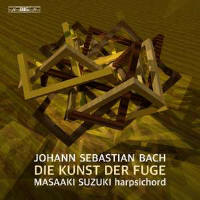Texte paru dans: / Appeared in:
|
|
|
|
|
|
Only weeks after, in reviewing Christophe Rousset’s recent Art of Fugue (Aparté, 1/24), I was saying how recordings of it on harpsichord were strangely infrequent, another one drops into the mix. And not without making a splash. For whether or not critical consensus is right in deciding that this great compendium of fugal techniques (originally printed in open score) was conceived as harpsichord music, no other account that I have heard so far has made it sound more like it. Not the much-admired, subtle straight-playing of Gustav Leonhardt (DHM, 10/79), nor the sweeter approach of Gramophone Award-winner Davitt Moroney (Harmonia Mundi, 5/86), nor the refined keyboard skills of Rousset. Masaaki Suzuki’s humanity as a Bach-player – already revealed in recordings of the English and French Suites – shines from every bar of this astounding but daunting work. If, as is often said, Bach saw fugue as simply the most natural medium for composing beautiful music, Suzuki demonstrates that it is also good for the exciting, the playful, the sombre, and perhaps any other feeling that might come up.
He achieves this mainly by applying more freedom to his interpretations than most, discreetly spreading chords and separating lines here and there, taking time over expressive and structural corners, and digging that little bit more meaningfully than most into articulation. Listen to the way clever and precise timing of note-release keeps the line swinging through the rests in the subjects of Contrapuncti 10 and 11. At no time, however, does any of this sound overdone or self-conscious. One is aware of it, but it always seems natural, and, better still,
helps give individual character to each fugue. Thus (to give examples) Contrapunctus 2 has a happy sense of well-being, 3 a 17th-century-style lyrical expressiveness like some elegant piece of Sweelinck (the crisply eloquent Ruckers copy by Willem Kroesbergen helps here), 5 something of the solemn inevitability of the ‘Gratias’ from the B minor Mass, the delicately articulated 8 a suave, stylish gait, and joy is thrillingly evident in the dancing swirl of the fugues for two harpsichords, in which Suzuki is joined by his son (as Bach himself may well have been). In short, these performances are consistently alive and personal.
Suzuki presents the work in the form in which it was posthumously printed in the 1750s, which is to say with the earlier twoharpsichord version of Contrapunctus 13, the uncompleted ‘Fuga a 3 soggetti’ with its dramatic break-off, and the added-in keyboard chorale Wenn wir in höchten Nöten sein. Leonhardt and Rousset omit these as not part of Bach’s original concept, but surely it is preferable to include them and let the buyer choose whether to listen to them. With playing as outstandingly listenable, stimulating and invigorating as Suzuki’s, who wouldn’t? |
|




